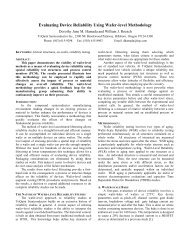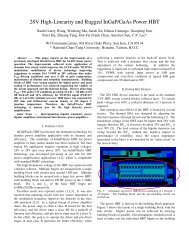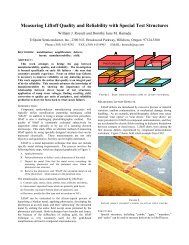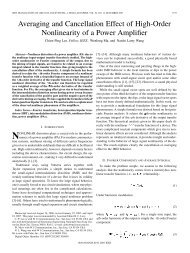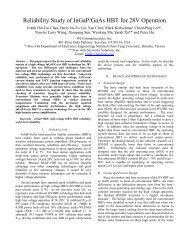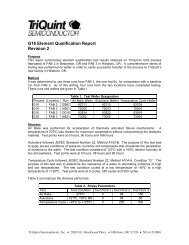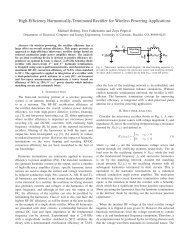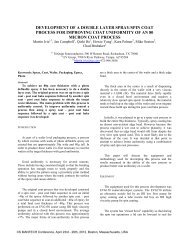TQTRx process Qualification PDF - TriQuint Semiconductor
TQTRx process Qualification PDF - TriQuint Semiconductor
TQTRx process Qualification PDF - TriQuint Semiconductor
Create successful ePaper yourself
Turn your PDF publications into a flip-book with our unique Google optimized e-Paper software.
Abstract<br />
<strong>TQTRx</strong> <strong>process</strong> <strong>Qualification</strong><br />
TQS Reliability Report # 00-09<br />
This report summarizes the reliability testing that has been completed to qualify the <strong>TQTRx</strong><br />
Process.<br />
The qualification vehicle was a MESFET Power Amplifier fabricated on <strong>TriQuint</strong>'s E/D MESFET<br />
GaAs <strong>process</strong> and packaged in a QSOP16 package with a heat slug. Assembly and<br />
encapsulation of the test samples were accomplished at supplier A. Tests, test sample size and<br />
failure criteria were defined from <strong>TriQuint</strong>’s Specification REL.021 (Policy and Procedure for<br />
Reliability <strong>Qualification</strong>s of ICs). Most tests outlined in this procedure follow the JEDEC<br />
Standard Number 26-A or MIL-STD-883 when applicable.<br />
For further information please contact:<br />
<strong>TriQuint</strong> <strong>Semiconductor</strong><br />
2300 N.E. Brookwood Parkway<br />
Hillsboro, OR 97124<br />
Phone: (503) 615-9000<br />
FAX: (503) 615-8900<br />
8/25/00
Process Description<br />
Page 2 of 9<br />
TQS Reliability Report # 00-09<br />
<strong>TriQuint</strong>’s <strong>TQTRx</strong> <strong>process</strong> is a Gallium Arsenide (GaAs) semiconductor <strong>process</strong> fabricated at <strong>TriQuint</strong>’s<br />
Hillsboro, Oregon facility<br />
The <strong>process</strong> is an Ion Implanted <strong>process</strong> combining 0.5 um gate length producing E, D, and Dmode<br />
MESFETs (Vp=100mV, -600mV, -2.0V), Schottky diodes, precision NiCr resistors, and<br />
MIM capacitors. Includes 2 layers of global, plated Au interconnect, but no Air Bridges.<br />
Product Description<br />
The MESFET power amplifier was designed for 800MHz AMPS and DAMPS applications, using a 4.6V<br />
supply voltage. Internal circuitry compensates for temperature and <strong>process</strong> variations.
Test Plan:<br />
Page 3 of 9<br />
TQS Reliability Report # 00-09<br />
Table 1 lists the qualification plan for <strong>TQTRx</strong>. This plan is based on the requirements of REL.021<br />
Test Description Purpose<br />
1. Moisture Sensitivity<br />
Level Testing<br />
Table 1. Device <strong>Qualification</strong> Test Plan.<br />
Specification - Method<br />
or Conditions<br />
1. Bias Life test Determine the effect of bias and<br />
temp on the device over an<br />
extended period of time<br />
IPC/JESD J-STD-020<br />
Moisture/Reflow Sensitivity<br />
Classification of Non-Hermetic Solid<br />
State Surface Mount Devices<br />
JESD22-A108<br />
150°C Junction - 1000 Hours Min<br />
1. PreConditioning JESD22-A113<br />
IR/Convection Reflow @ 235°C<br />
2. Autoclave Determine the effect of temp, JEDEC A102, Condition C<br />
humidity & pressure on the 121<br />
device over time, unbiased.<br />
o C, 100% RH, 15 PSIA<br />
unbiased, for 96 Hours<br />
3. HAST Determine the effect of temp &<br />
humidity on the device under bias.<br />
4. Temperature Cycle Determine the effect of temp on<br />
Material Thermal Mismatch.<br />
1. Thermal Shock Determine the effect of temp on<br />
Material Thermal Mismatch.<br />
JESD22-A110 - 96 hr<br />
130°C - 85% RH Non-Condensing<br />
JESD22-A104 Cond G<br />
-40°C to +125°C 1000 Cycles<br />
Similar to JESD22-A106 Cond. C<br />
except -40°C to +125°C - 100 Cycles<br />
Sample<br />
Size<br />
1 Lot<br />
3Lot<br />
77 (1)<br />
3 Lot<br />
320 (1)<br />
3 Lot<br />
77 (1)<br />
3 Lot<br />
77 (1)<br />
3 Lot<br />
77 (1)<br />
3 Lot<br />
77 (1)<br />
2. Physical Dimensions JESD22-B100-A 3 Lot<br />
15 (0)<br />
3. Lead Integrity EIA/JESD22-B105 Cond. A & B<br />
(25 leads/Cond)<br />
4. Mark Permanency EIA/JESD22-B107 3 Lot<br />
25 (1)<br />
5. Solderability EIA/JESD22-B102 Cond A 3 Lot<br />
5(0)<br />
1. ESD Sensitivity<br />
Determine the sensitivity of the<br />
device to levels of ESD<br />
3 Lot<br />
10<br />
HBM per EIA/JESD22-A114 1 Lot<br />
3<br />
2. ESD Sensitivity CDM per JESD22-C101 1 Lot<br />
3<br />
Note: HAST, Autoclave, & Temperature Cycle groups received preconditioning. Please see description of preconditioning stresses.
Summary of Results:<br />
Table 2 lists the status and results of the qualification testing for the <strong>TQTRx</strong> <strong>process</strong>.<br />
(The present status of the tests is listed in the following section.)<br />
Table 2. <strong>Qualification</strong> Test Results Summary.<br />
Test Description<br />
Sample<br />
Size Status<br />
Page 4 of 9<br />
TQS Reliability Report # 00-09<br />
Preliminary<br />
Lot Lot #1 Lot #1A Lot #2 Lot #3<br />
Moisture Sensitivity<br />
Level Testing<br />
1 Lot Passed<br />
Bias Life test 3Lot<br />
Completed Completed Completed Completed<br />
77 (1)<br />
1,000 hrs. 1,000 hrs. 1,000 hrs. 1,000 hrs.<br />
77/2 77/0 77/0 77/0<br />
PreConditioning 3 Lot<br />
231 / 0 249/3<br />
320 (1)<br />
FA<br />
Cracked Die<br />
240/0 240/0 240/0<br />
Autoclave 3 Lot<br />
77 / 0 73/0<br />
77 (1)<br />
1 part lost<br />
and 3 part<br />
damaged by<br />
the handler<br />
77 / 0 77 / 1 77 / 0<br />
HAST 3 Lot<br />
77 / 0 Test<br />
77 (1)<br />
Canceled<br />
Board<br />
Overheated<br />
77/2 77 / 1 77 / 0<br />
Temperature Cycle 3 Lot<br />
77 / 1 76/0 77/0 77/0 77/0<br />
77 (1)<br />
(FAR 851) 1 part lost<br />
Thermal Shock 3 Lot<br />
77 (1)<br />
77/0 77/0 77/0 77/0<br />
Physical Dimensions 3 Lot<br />
15 (0)<br />
Passed Passed Passed<br />
Lead Integrity 3 Lot<br />
10<br />
Passed Passed Passed<br />
Mark Permanency 3 Lot<br />
25 (1)<br />
Passed Passed Passed<br />
Solderability 3 Lot<br />
5(0)<br />
Passed Passed Passed<br />
ESD Sensitivity HBM 1 Lot<br />
Completed Passed<br />
3<br />
300V<br />
ESD Sensitivity CDM 1 Lot<br />
Completed Passed Passed<br />
3<br />
600V 600V<br />
NOTE: Lot 1A is a replacement lot for #1 which had die cracking
Test Status:<br />
Page 5 of 9<br />
TQS Reliability Report # 00-09<br />
Moisture Sensitivity Level Testing TQS Test#664<br />
Procedure: Moisture Sensitivity Level Testing is performed per IPC/JESD J-STD-020.<br />
Purpose: The purpose of this testing is to identify the classification level of non-hermetic solid state<br />
Surface Mount Devices. (Sensitivity of the product / package type to moisture exposure)<br />
Results: Ten parts from lot 7287 were subjected to level 1 Moisture Sensitivity testing - and all<br />
passed electrical test after stress.<br />
HTOL (High Temperature Operating Lifetest) TQS Test#663, 667, 670, 931<br />
Procedure: In general, the life test procedure follows MIL-STD-883, Method 1005, Condition B or<br />
JESD22-A108.<br />
Purpose: Life testing is performed for the purpose of demonstrating that device failure rates do not<br />
exceed 100 FIT (FIT = Failure unIT = failures per billion device hours) for the first 20 years of<br />
life at the specified maximum rated operating temperature.<br />
Results: - Test 663 has completed 500 hr of HTOL with one failure (FAR 954)<br />
FA determined that the failure was due to EOS.<br />
At 1,007 hrs 1 additional part failed for a random fab defect - Interstage cap short.<br />
- Test 667 All parts passed after 1,000 hr of HTOL<br />
- Test 670 All parts passed after 1,000 hr of HTOL<br />
- Test 931 All parts passed after 1,000 hr of HTOL<br />
♦ Environmental Test Group<br />
Preconditioning TQS Test#536 & 662, 666, 668, 933<br />
Procedure: Preconditioning is performed according to JEDEC Methods A101 & A113.<br />
Purpose: The purposes of preconditioning are:<br />
(1) to determine if any trapped moisture around the device leads will explode the plastic<br />
around the leads (popcorning) or cause delamination of the plastic from the chip during<br />
the soldering <strong>process</strong>.<br />
(2) to determine if the solder reflow will have any long-term effect on reliability.<br />
Results: - Preliminary test 536 (lot 19547) is complete and the 231 parts that were subjected<br />
to level 1 preconditioning had no electrical failures.<br />
- Test 662 (lot 5130) is complete and of 249 parts there were 3 failures. FA indicated that<br />
the failures were due to cracked die. This problem has been traced to the assembly<br />
facility<br />
- Test 666 (Lot 6952) is complete an all 240 parts passed electrical test after stress.<br />
- Test 668 (Lot 7287) is complete an all 240 parts passed electrical test after stress.<br />
- Test 933 (Lot 7302) is complete an all 240 parts passed electrical test after stress.<br />
Autoclave TQS Test#536 & 662, 666, 668, 933<br />
Procedure: Un-Biased Autoclave is performed per JESD22-A102<br />
Purpose: The purpose of unbiased autoclave (Accelerated Moisture Resistance Test) is to evaluate<br />
the moisture resistance of non-hermetic packaged solid state devices.<br />
Results: - Preliminary test 536 (lot 19547) is complete and 77 parts were subjected to 96 hr<br />
of Autoclave with no electrical failures.<br />
- Test 662 (lot 5130) 77 parts were subjected to 96 hr of Autoclave with no electrical failures.<br />
One part was lost in the handler and 3 parts were damaged by the handler.<br />
- Test 666 (Lot 6952) 77 parts were subjected to 96 hr of Autoclave with no electrical<br />
failures.
Page 6 of 9<br />
TQS Reliability Report # 00-09<br />
- Test 668 (Lot 7287) 77 parts were subjected to 96 hr of Autoclave with 1 electrical failure.<br />
- Test 933 (Lot 7302) 77 parts were subjected to 96 hr of Autoclave with no electrical failures
Page 7 of 9<br />
TQS Reliability Report # 00-09<br />
HAST (Highly Accelerated Temperature & Humidity Stress Test) TQS Test#536 & 662, 666, 668, 933<br />
Procedure: HAST is performed according to JESD22-A110; with the parts biased and an environment of<br />
131°C 85% RH for 96 hrs.<br />
Purpose: The purpose of the test is to evaluate the reliability of non-hermetic packaged solid state<br />
devices in a biased humid environment. This test usually activates the same type of failures<br />
as does biased 85/85 but accelerated by temperature, pressure and humidity.<br />
Results: - Preliminary test 536 (lot 19547) is complete and 77 parts were subjected to 96 hr of<br />
HAST<br />
with no electrical failures.<br />
- Test 662 (Lot 5130) is complete - The board and the parts overheated and were damaged.<br />
- Test 666 (Lot 6952) 75 of 77 parts passed electrical test.<br />
Two (2) parts failed for random fab defects that caused capacitor shorts.<br />
- Test 668 (Lot 7287) 77 parts were subjected to 96 hr of HAST with 1 electrical failure.<br />
- Test 933 (Lot 7302) 77 parts were subjected to 96 hr of HAST with no electrical failures<br />
Temperature Cycle TQS Test#536 & 662, 666, 668, 933<br />
Procedure: Temperature cycle is performed according to JESD22-A104 Condition G,<br />
-40°C to +125°C, for 1000 cycles.<br />
Purpose: The purpose of the test is to determine the resistance of the part to extremes of high and low<br />
temperature and the effect of alternate exposures to these extremes.<br />
Results: - Test 536 (lot 19547) is complete 77 parts were subjected to 1,000 temperature cycles from<br />
-40ºC to +125ºC - One electrical failure was detected after 1,000 cycles. Failure analysis<br />
(FAR 851) indicated that the failure was related to degradation of a FET..<br />
- Test 662 (Lot 5130) complete 1,000 cycles - One (1) part was lost in the handler - the<br />
remaining 76 parts all passed.<br />
- Test - 666 (Lot 6952) completed 1,000 cycles with no failures.<br />
- Test - 668 (Lot 7287) completed 1,000 cycles with no failures.<br />
- Test - 933 (Lot 7302) completed 1,000 cycles with no failures.<br />
♦ Mechanical Test Group<br />
Thermal Shock (Liquid to Liquid) TQS Test# 665, 669, 671, 932<br />
Procedure: The test shall be performed according to JESD22-A106 Condition C except –40°C to +125°C<br />
Purpose: The purpose of the test is to determine the resistance of a part to sudden exposure to<br />
extreme changes in temperature and to the affect of alternate exposures to these extremes.<br />
Results: - Test 663 (Lot 5130) was subjected to 100 cycles between –40°C to +125°C with<br />
no electrical failures.<br />
- Test 665 (Lot 5130) was subjected to 100 cycles between –40°C to +125°C All 77 Passed<br />
- Test 669 (Lot 6952) was subjected to 100 cycles between –40°C to +125°C All 77 Passed<br />
- Test 671 (Lot 7287) was subjected to 100 cycles between –40°C to +125°C All 77 Passed.<br />
- Test 932 (Lot 7302) was subjected to 100 cycles between –40°C to +125°C All 77 Passed.<br />
Physical Dimensions TQS Test# 669, 671, 932<br />
Procedure: The test shall be performed according to JESD22-B100.<br />
Purpose: The purpose of this test is to determine whether the external physical dimensions of the<br />
device, in all package configurations, are in accordance with the applicable documents.<br />
Results: - Test 669 (Lot 6952) - Passed<br />
- Test 671 (Lot 7287) - Passed<br />
- Test 932 (Lot 7302) - Passed
Page 8 of 9<br />
TQS Reliability Report # 00-09<br />
Lead Integrity TQS Test# 669, 671, 932<br />
Procedure: The test shall be performed according to JESD22-B105 Cond. A & B.<br />
Purpose: The purpose of the test is to determine the integrity of the lead/package interface and the<br />
lead itself where the lead(s) are bent due to faulty board assembly followed by rework of the<br />
parts for re-assembly<br />
Results: - Test 669 (Lot 6952) - Passed<br />
- Test 671 (Lot 7287) - Passed<br />
- Test 932 (Lot 7302) - Passed<br />
Marking Permanency TQS Test# 669, 671, 932<br />
Procedure: The test shall be performed according to JESD22-B107.<br />
Purpose: The purpose of the test is to verify that the markings on the device will not become illegible<br />
when subjected to solvents of cleaning solutions commonly used during the removal of<br />
solder flux residue from the board assembly <strong>process</strong><br />
Results: - Test 669 (Lot 6952) - Passed<br />
- Test 671 (Lot 7287) - Passed<br />
- Test 932 (Lot 7302) - Passed<br />
Solderability TQS Test# 669, 671,932<br />
Procedure: The test shall be performed according to JESD22-B102.<br />
Purpose: The purpose of this test is to provide a means of determining the solderability of devices<br />
package terminations that are intended to be joined to another surface using solder for the<br />
attachment.<br />
Results: - Test 669 (Lot 6952) - Passed<br />
- Test 671 (Lot 7287) - Passed<br />
- Test 932 (Lot 7302) - Passed<br />
♦ ESD Test Group<br />
ESD Testing (HBM) TQS Test#703,<br />
Procedure: This testing will be performed per EIA/JESD22-A114<br />
Purpose: The purpose of this testing is to classify the device according to its susceptibility to damage<br />
or degradation by exposure to a defined electrostatic HBM discharge.<br />
Results: ESD testing on Lot# 1 completed. Pin4 (Gnd) to Pin11 (RFoutD) Failed at +400V<br />
Pin2 (VregA) to Pin1 (Vds1A) Failed at +500V<br />
Pin2 (VregA) to Pin8 (Vds1D) Failed at +500V<br />
Pin7 (VregD) to Pin11 (RFoutD) Failed at +500V<br />
All remaining pin combinations exceeded 500V<br />
ESD Testing (CDM) TQS Test# 934, 935<br />
Procedure: This testing will be performed per EIA/JESD22-C101<br />
Purpose: The purpose of this testing is to classify the device according to its susceptibility to damage<br />
or degradation by exposure to a defined electrostatic CDM discharge.<br />
Results: Parts from lot 7287 were subjected to CDM ESD and all passed at 600V.<br />
Parts from lot 7302 were subjected to CDM ESD and all passed at 600V.
Conclusion<br />
Page 9 of 9<br />
TQS Reliability Report # 00-09<br />
The <strong>TQTRx</strong> <strong>process</strong> has successfully completed all reliability testing per the requirements specified<br />
in REL.021 and is now considered to be qualified.


